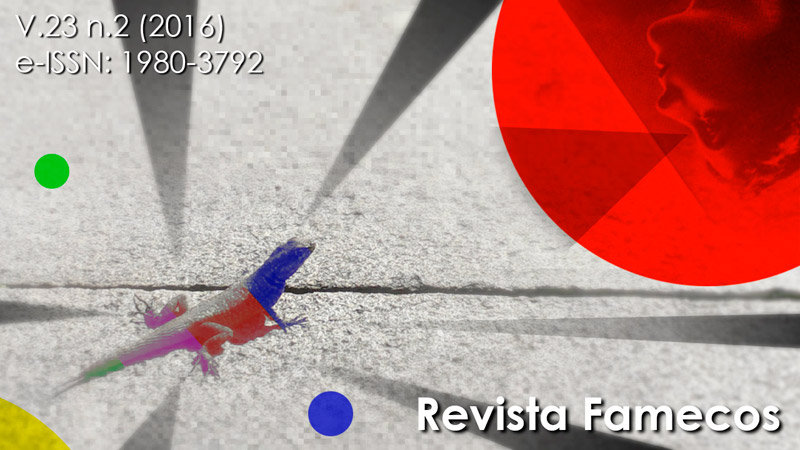Mediatized controversies in Twitter during live television: the “exoskeleton” network in the 2014 FIFA World Cup opening ceremony
DOI:
https://doi.org/10.15448/1980-3729.2016.2.21106Keywords:
Communication, Twitter, World CupAbstract
This paper discusses the emergency of retweets networks motivated by live TV transmissions. Based in Actor-Network Theory, the paper considers networks as result of assemblages and agencies that must be analysed in a temporal way, in opposition to a structuralist approach. It’s also discussed how the debates on Twitter reconfigures previous sociotechnical controversies as well as how the mediatization of these controversies alters the methods used to study them. The case study is based in a dataset of 25.115 retweets collected in Twitter about the demonstration of an exoskeleton during 2014 FIFA World Cup opening ceremony. Two methodological approaches are proposed to analyse the subject of the debates and to show in a video and graphs how the RTs networks changed during the transmission.Downloads
References
ALVES, Marcelle. A agência de humanos e não humanos na rede Miguel Nicolelis. Comtempo, São Paulo, dez. 2014.
BEGUOCCI, Leandro; BURGIERMAN, Denis. Milagre ou Truque? Revista Superinteressante, São Paulo, p.40-49, jun.2014.
BRUNS, Axel & BURGESS, Jean E. The use of Twitter hashtags in the formation of ad hoc publics. In: 6th European Consortium for Political Research General Conference, 2011, Reykjavik. Anais... Reykjavik: University of Iceland, 2011.
CALLON, Michel. Entrevista: Dos estudos do laboratório aos estudos de coletivos heterogêneos, passando pelos gerenciamentos econômicos. Sociologias, Porto Alegre, ano 10, n. 19, p. 302, jan./jun. 2008.
______. La dinamica de las redes tecno-economicas. In: THOMAS, Hérnán, BUCH, Alfonso. Actos, actores y artefactos – Sociologia de la tecnologia. Bernal: Universidade Quilmes, 2013. p.147-163.
CRAWFORD, Cassandra. Actor Network Theory. In: RITZER, George. Encyclopedia of Social Theory. Sage, 2004.
D´ANDRÉA, Carlos. TV + Twitter: reflexões sobre uma convergência emergente. In: SOSTER, Demétrio; LIMA JR., Walter (org.). Jornalismo digital: audiovisual, convergência e colaboração. Santa Cruz do Sul: Edunisc, 2011. p.43-63.
D'ANDRÉA, Carlos. Conexões intermidiáticas entre transmissões audiovisuais e redes sociais online: possibilidades e tensionamentos. In: XVIII Encontro Anual da Compós, 2014, Belém (PA). Anais... Belém: Compós, 2014.
DAYAN, Daniel; KATZ, Elihu. La Historia en Directo: La Retransmisión Televisiva de Los Acontecimientos. Barcelona: Gustavo Gili Editorial, 1995.
DE WOLF, Tom; HOLVOET, Tom. Emergence Versus Self-Organisation: Different Concepts but Promising When Combined. Lecture Notes in Computer Science, v. 3464, p. 1-15, 2005.
ESTEVES, Bernardo. O chute. Revista Piauí, dez. 2011
FECHINE, Yvana. Televisão transmídia: conceituações em torno de em torno de novas estratégias e práticas interacionais da TV; In: XXII Encontro Anual da Compós, 2013, Salvador (BA). Anais... Salvador: Compós, 2013.
GRAEFF, E; STEMPECK, M; ZUCKERMAN, E. The battle for Trayvon Martin': Mapping a media controversy online e off-line. First Monday, v. 9, n. 2-3, fev.2014.
HEPP, Andreas. As configurações comunicativas de mundos midiatizados: pesquisa da midiatização na era da “mediação de tudo”. Matrizes, São Paulo, v. 8, n.1, p. 21-44, jan/jun. 2014.
HOLME, Petter, SARAMAKI, Jan. Temporal Networks. Physics Reports, v. 519, n.3, p.97-125, 2012.
JOST, François. Compreender a televisão. Porto Alegre: Sulina, 2007.
LATOUR, Bruno. A Esperança de Pandora: ensaios sobre a realidade dos estudos científicos. Bauro: Edusc, 2001. 371 p.
LEMES, Conceição. O que há por trás da previsão de fracasso do esqueleto-robô da Copa. Viomundo, 2014. Disponível em: http://www.viomundo.com.br/ denuncias/nicolelis-2.html.
LEMOS, André. A comunicação das coisas - Teoria Ator-Rede e cibercultura. São Paulo: Annablume, 2013.
MARRES, Noortje. Why Map Issues? On Controversy Analysis as a Digital Method. No prelo, 2015.
VENTURINNI, Tommaso. Diving in magma: how to explore controversies with actor-network theory. Public Understanding of Science, v. 19, n.3, p.258-273, mai./2010.
______. What’s in a controversy. Deploying the folds of collective action. 2013. Disponível em: http://pt.slideshare.net/tommasoventurini/3-what-cmdeployingfolds. Acesso em: 09 jan. 2015.
VENTURINI, T., JACOMY, Mathieu; PEREIRA, Debora. Visual Network Analysis. No prelo, 2014.
VENTURINI, T., RICCI, D., MAURI, M., KIMBELL, L., & MEUNIER, A. (2014). Designing Controversies and their Publics. Design Issues. No prelo, 2014.
Downloads
Published
How to Cite
Issue
Section
License
Copyright
The submission of originals to Revista Famecos implies the transfer by the authors of the right for publication. Authors retain copyright and grant the journal right of first publication. If the authors wish to include the same data into another publication, they must cite Revista Famecos as the site of original publication.
Creative Commons License
Except where otherwise specified, material published in this journal is licensed under a Creative Commons Attribution 4.0 International license, which allows unrestricted use, distribution and reproduction in any medium, provided the original publication is correctly cited.






